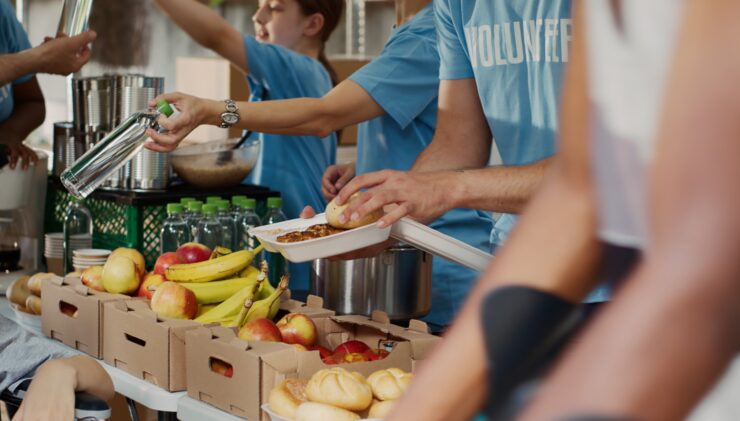 Navigating Nonprofit Insurance: Safeguarding Your Mission and Vision
Navigating Nonprofit Insurance: Safeguarding Your Mission and VisionNearly 13% of U.S. households experienced food insecurity in 2022, according to the USDA. Food banks provide a valuable service and help individuals and families secure the nutrition they need. However, food banks also have considerable food safety risks, making food bank risk management critical.
Food Poisoning at Food Banks and Shelters
Food safety is a concern for any organization that provides provide. However, food banks, shelters and other nonprofits often receive donations of food that may not be fresh, and this can increase the risk of dangerous bacteria and other types of contamination. Furthermore, as Food Safety News points out, many food recipients belong to high-risk groups, such as children, the elderly and people who are sick.
When the food distributed by a nonprofit is contaminated, many people can suffer. In one particularly large incident that took place in 2012, ABC News say 60 people had to be hospitalized after eating a turkey dinner at a homeless shelter in Denver. In another case, ABC Eyewitness News says homeless shelter residents in Brooklyn filed a lawsuit after getting violently ill from eating expired chicken salad that had allegedly been given a new label to make it look like it was still good. More recently, The City says several children became ill after eating food from a shelter, and when adults later inspected the remaining food, it was allegedly green, slimy and foul-smelling.
Good Samaritan Protection
The USDA says people and organizations that provide food donations receive some liability protection under the Good Samaritan Food Donation Act of 1996. The law expressly covers donations from food banks and other nonprofit food distributors. However, it does not cover organizations that sell food at extremely low prices to help underserved neighborhoods. Furthermore, it only covers food donations of apparently wholesome food or apparently fit grocery products provided in good faith. Food banks also need to be aware of state laws on food donor liability, which can vary widely.
While Good Samaritan laws provide some liability protection for nonprofits, safety is still critical. For one thing, nonprofits may still be held liable under some circumstances, such as if it’s shown that the nonprofit knew or should have known the food could be dangerous. Additionally, nonprofits aim to help vulnerable populations, and food poisoning runs counter to that mission. In some cases, food poisoning can even prove fatal, especially for individuals who have weakened immune systems.
Food Safety Best Practices
Strong food safety best practices can reduce liability while keeping vulnerable populations safe.
- Review the food safety requirements in your jurisdiction.
See if the food health department offers any guidance or training. Also, find out if safe food handling permits are required.
- Train staff and volunteers in safe food handling.
The USDA recommends the steps below. While these steps may seem like common sense, consistent training and procedure auditing is essential to ensure the steps are always followed:
- Wash hands and surfaces frequently.
- Separate different types of food to avoid cross-contamination. For example, raw meat, poultry and fish should be kept away from other food; this includes juices and items that come in contact with raw meat, such as cutting boards and utensils.
- Use a food thermometer to confirm that foods have been cooked to safe temperatures. For example, poultry should be cooked to an internal temperature of at 165° F, ground meats should be cooked to an internal temperature of 160° F and beef, pork, lamb and veal steaks chops and roasts should be cooked to a minimum temperature of 145° F.
- Refrigerate uneaten food promptly.
- Assess food donations for quality.
Some people may donate food that is already expired or that has gone bad and is not fit for human consumption. According to the FDA, food is not necessarily unsafe just because the sell-by date has passed, but safe handling is important. However, refrigerated foods are often perishable and may have begun to spoil if the sell-by or use-by date has passed.
Check expiration dates, inspect items for signs of spoilage, and look for damage that could lead to contamination, such as dented cans, rusted seams, leaks or torn packaging. If you accept expired food, establish rules for what is allowable, and make sure these rules are in line with the health guidelines in your jurisdiction.
- Rotate and label food.
Establish procedures for the labeling and rotation of food. This will help ensure that the oldest food is used first, which increases food safety while also reducing spoilage and waste.
- Maintain proper temperatures.
The danger zone for food occurs between 40° F and 140° F. In this temperature range, bacteria can grow quickly, making food unsafe.
Food that is left out at room temperature for more than two hours should be discarded. When the temperature is above 90° F, discard food after one hour. Leftovers should be reheated to 165° F before serving.
- Educate staff and volunteers on food allergies.
Food allergies can be life threatening. According to the Mayo Clinic, approximately 8% of children under the age of five and 4% of adults have food allergies. Although people can be allergic to a wide range of ingredients, the Cleveland Clinic says the most common allergens are milk, eggs, peanuts, tree nuts, shellfish, fish, wheat, soybeans and sesame. If someone asks about food allergens, it’s important to provide an accurate response and warn about any possible cross contamination, such as if cooking utensils may have been exposed to the allergen. Severe allergic reactions require immediate medical care.
A Knowledgeable Risk Management Partner
In addition to providing invaluable risk management resources, a niche-focused insurance partner can help protect your organization and your mission. Heffernan Insurance Brokers offers insurance designed for nonprofit organizations including food banks, shelters and religious organizations. Learn more.


